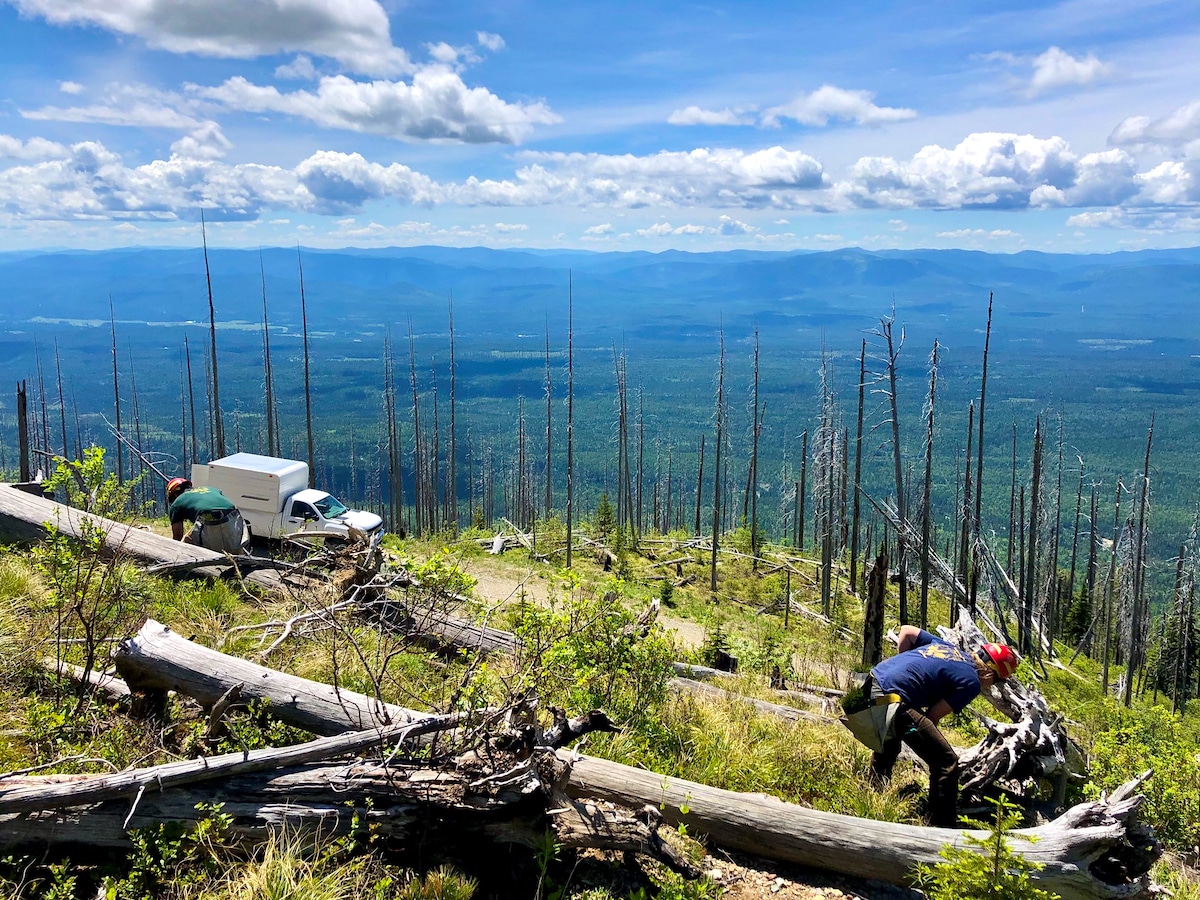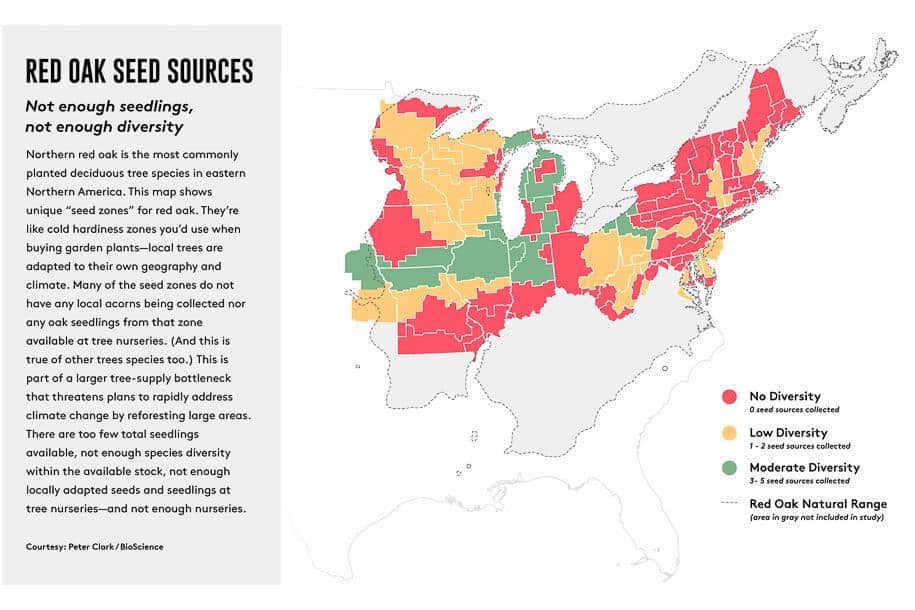U.S. Forest Service Plan to Plant More Than a Billion Trees Limited by Lack of Seedlings, Study Finds

 Why you can trust us
Why you can trust us
Founded in 2005 as an Ohio-based environmental newspaper, EcoWatch is a digital platform dedicated to publishing quality, science-based content on environmental issues, causes, and solutions.
In order to fulfill the ambition of the United States federal government’s REPLANT Act, the U.S. Forest Service has funds available to plant more than a billion trees in the next nine years. The problem is, there aren’t enough trees. Not only that, but U.S. tree nurseries don’t have enough variety of species necessary to meet the goal.
Cities around the world are suffering from urban heat islands made unbearable by record heat waves. According to the U.S. Department of Energy, air temperatures underneath trees can be as much as 25 degrees Fahrenheit cooler than directly above blacktop.
A new study by scientists at the University of Vermont (UVM) has shown that the limited diversity of tree species available has frustrated how much the forest service can do to respond to the climate crisis by planting trees, a press release from UVM said.
“Trees are this amazing natural solution to a lot of our challenges, including climate change. We urgently need to plant many millions of them,” said professor and director of the UVM Forestry Program Tony D’Amato, who co-led the research, in the press release. “But what this paper points out is that we are woefully underserved by any kind of regional or national scale inventory of seedlings to get the job done.”
The study, “A lack of ecological diversity in forest nurseries limits the achievement of tree-planting objectives in response to global change,” was published in the journal BioScience.
In their research, the team of 13 scientists looked at 605 plant nurseries in 20 northern U.S. states. They found that just 14 of them were operated by the government, and only 56 of them grew and sold seedlings in adequate amounts for reforestation and conservation.
Even more disappointing for the researchers was the “overwhelming scarcity of seedlings” from varied species and “seed collection zones,” which refer to local climates and conditions that trees have adapted to, they wrote in the study, according to UVM.

The research team found that forest nurseries have a tendency to keep a limited inventory of a few tree species, such as those used in commercial timber production, rather than species necessary for ecological restoration, climate adaptation or conservation. They also discovered that, in many areas, no locally adapted trees were available.
“The world is thinking about a warming climate — can we plant towards that warming climate? We know we’re losing ecologically important species across North America and around the world. So, the goal is: can we restore these trees or replace them with similar species? It’s a powerful idea,” said Peter Clark, UVM applied forest ecologist and lead author of the study, in the press release. “But — despite the excitement and novelty of that idea in many policy and philanthropy circles — when push comes to shove, it’s very challenging on the ground to actually find either the species or the seed sources needed… [F]inding the diversity we need to restore ecologically complex forests — not just a few industrial workhorse species commonly used for commercial timber operations, like white pine — is an even bigger bottleneck.”
The researchers said a much larger amount of seedlings and diversity within those is needed at regional nurseries in order to achieve a successful tree planting program directed at addressing climate change.
The financial risk and novelty involved in providing increased variety “likely generates uncertainty among forest nurseries, hampering investment,” the authors of the study wrote.
Another issue is that the number of nurseries, especially in the northeastern U.S., has gone down in recent years.
Seedlings from a different region might also have trouble succeeding in a new area, the researchers found. For instance, 80 percent of the seedings in the study found in northern states were produced in north central states.
“Such concentration of production will hinder tree planting efforts,” the researchers wrote, “because species and seed sources likely originate from similar geographic or bioclimatic zones.”
This is exacerbated by seedlings being sensitive to stress. A mismatch between when they are available, such as earlier in nurseries farther south, and when they need to be planted, like in northern soils after the last frost, could be an issue.
The researchers suggested improvements in financing and policy, as well as expanded research and better training to help alleviate these issues.
Government agencies like the U.S. Forest Service, as well as state governments, rely on seed zones from the 1970s based on climate conditions that are very different from those predicted for the future. Also, forest research and policy has been centered around timber production species rather than those that are more adapted to changing climates and a more diverse array of tree species. Clear policies regarding tree genetics and tree species’ movement are also lacking in many government policies.
The scientists recommended an expansion of state and federal investment in seed collection and public tree nurseries.
“This strategy may stimulate production from private nurseries once a stable demand is apparent,” the authors of the study wrote.
This year, the federal government invested $35 million in expanding the capacity of the federal nursery, but the authors of the study said that, due to “the existing (and growing) reforestation backlog, declines in nursery infrastructure, and complex needs for diverse seeds and seedlings, it is likely that substantially more public investment in the form of grants, loans, and cost-share programs will be needed to reinvigorate, diversify, and expand forest nurseries.”
“People want trillions of trees,” Clark said in the press release, “but often, on the ground, it’s one old farmer walking around to collect acorns. There’s a massive disconnect.”
Subscribe to get exclusive updates in our daily newsletter!
By signing up, you agree to the Terms of Use and Privacy Policy & to receive electronic communications from EcoWatch Media Group, which may include marketing promotions, advertisements and sponsored content.

 233k
233k  41k
41k  Subscribe
Subscribe 




